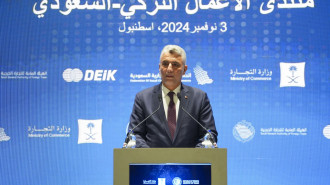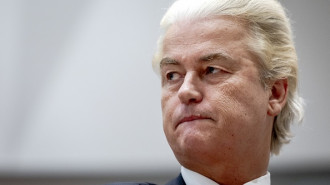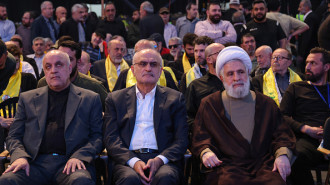IS leader Baghdadi 'trapped in Mosul', Iraqi militias claim
IS leader Baghdadi 'trapped in Mosul', Iraqi militias claim
Following earlier claims from Iraq's Popular Mobilisation Forces militias that Baghdadi had escaped besieged Mosul, a leader from the group now believes the IS leader is stuck in the city.
3 min read
Baghdadi has not made a public appearance since 2014
Islamic State group leader Abu Bakr al-Baghadi might be trapped in Mosul having failed to escape the besieged city according to an Iraqi militia leader.
Baghdadi was believed to have fled Iraq - likely for the IS' self-declared capital Raqqa in eastern Syria - shortly after a Kurdish and Iraqi army offensive on Mosul was launched in October.
Now a leading figure in the Popular Mobilisation Forces - an umbrella group of mostly Shia militias - said he believes Baghdadi did not leave the city when the assault began.
"Initial information with the intelligence bodies tell that… Abu Bakr al-Baghdadi remains in Nineveh [Mosul province]… as security forces impose control over the eastern side of Mosul, while the western side is totally isolated from Syrian territories," said Jawad al-Tleibawai, a militia leader.
He also claimed that there is intelligence sharing between the US and Popular Mobilisation Forces, which Washington has publically refused to cooperate with.
"Joint intelligence operations were formed recently between the Joint Special Operations command and the PMF to monitor Baghdadi's movement as well as the movement of other IS terrorist leaders," he told media.
US air power, intelligence and training continue to play a crucial role in the Iraqi army's campaign in Mosul, which has so far seen IS lose most of the eastern section of the city.
But the Popular Mobilisation Forces were excluded from the offensive due to fears of atrocities against civilians in the city.
Some Shia militias are believed to be fighting with the Iraqi army, while the Popular Mobilisation Forces are thought to wield huge political influence and have the support of leading Iraqi politicians.
Instead, the paramilitary force's main role has been to cut off a potential IS western retreat to Raqqa.
Some of these militias were involved in the siege on the nearby Turkman-majority town of Tal Afar, where Baghdadi was believed to have fled to.
There have been numerous theories regarding Baghdadi's fate but none confirmed or backed with strong evidence, at least publically.
In December, a Russian intelligence officer claimed that Baghdadi was killed in an airstrike. Iraqi militias had previously said that the self-declared caliph fled to Tal Afar before escaping to Syria.
There have been other reports that Baghdadi is hiding on the Syrian border, while Iraqi intelligence appear to believe he is still in Mosul.
Baghdadi is said to be "intemperate" since the assault on Mosul began, according to one Mosul insider allegedly feeding information to Iraqi intelligence.
"He has cut down on his movements and neglects his appearance. He lives underground and has tunnels that stretch to different areas. He doesn't sleep without his suicide bomber vest so he can set it off if he's captured," the informer told Iraqi forces in a text message, according to Reuters.
Baghdadi was believed to have fled Iraq - likely for the IS' self-declared capital Raqqa in eastern Syria - shortly after a Kurdish and Iraqi army offensive on Mosul was launched in October.
Now a leading figure in the Popular Mobilisation Forces - an umbrella group of mostly Shia militias - said he believes Baghdadi did not leave the city when the assault began.
"Initial information with the intelligence bodies tell that… Abu Bakr al-Baghdadi remains in Nineveh [Mosul province]… as security forces impose control over the eastern side of Mosul, while the western side is totally isolated from Syrian territories," said Jawad al-Tleibawai, a militia leader.
He also claimed that there is intelligence sharing between the US and Popular Mobilisation Forces, which Washington has publically refused to cooperate with.
"Joint intelligence operations were formed recently between the Joint Special Operations command and the PMF to monitor Baghdadi's movement as well as the movement of other IS terrorist leaders," he told media.
US air power, intelligence and training continue to play a crucial role in the Iraqi army's campaign in Mosul, which has so far seen IS lose most of the eastern section of the city.
But the Popular Mobilisation Forces were excluded from the offensive due to fears of atrocities against civilians in the city.
Some Shia militias are believed to be fighting with the Iraqi army, while the Popular Mobilisation Forces are thought to wield huge political influence and have the support of leading Iraqi politicians.
 |
Abu Bakr al-Baghdadi remains in Nineveh [Mosul province]… as security forces impose control over the eastern side of Mosul. - Jawad al-Tleibawai, Iraqi militia leader |
 |
Instead, the paramilitary force's main role has been to cut off a potential IS western retreat to Raqqa.
Some of these militias were involved in the siege on the nearby Turkman-majority town of Tal Afar, where Baghdadi was believed to have fled to.
There have been numerous theories regarding Baghdadi's fate but none confirmed or backed with strong evidence, at least publically.
In December, a Russian intelligence officer claimed that Baghdadi was killed in an airstrike. Iraqi militias had previously said that the self-declared caliph fled to Tal Afar before escaping to Syria.
There have been other reports that Baghdadi is hiding on the Syrian border, while Iraqi intelligence appear to believe he is still in Mosul.
Baghdadi is said to be "intemperate" since the assault on Mosul began, according to one Mosul insider allegedly feeding information to Iraqi intelligence.
"He has cut down on his movements and neglects his appearance. He lives underground and has tunnels that stretch to different areas. He doesn't sleep without his suicide bomber vest so he can set it off if he's captured," the informer told Iraqi forces in a text message, according to Reuters.







 Follow the Middle East's top stories in English at The New Arab on Google News
Follow the Middle East's top stories in English at The New Arab on Google News


